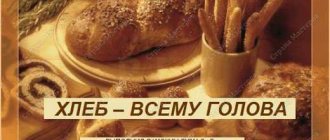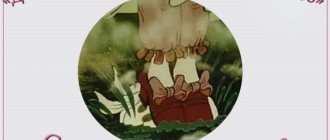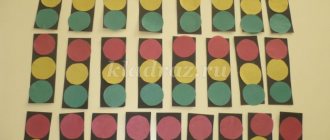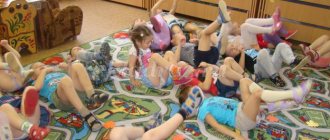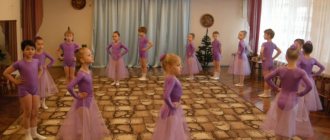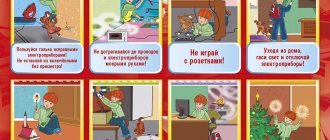Entertainment summary for the middle group “Bread is the head of everything”
Inna Conversation
Summary of entertainment for the middle group “Bread is the head of everything”
Entertainment summary for the middle group “ Bread is the head of everything ”
.
Goal: To foster a sense of respect for the workers of Kuban, to instill a sense of pride in the people who sow, grow and harvest grain , gratitude for the work of grain growers .
Tasks. To form an idea of bread as a condition for the existence of people on earth, as one of the main foodstuffs, about how we get bread .
Introduce children to the commandments of the Russian people in relation to bread , with poems, proverbs and sayings about bread .
Cultivate a caring attitude towards bread , a caring attitude towards work.
Move. Educator. Today we have gathered with you to talk about bread . grain growers work tirelessly bring bread to every home and table !
Since ancient times, in Kuban, there has been a custom: dear guests are greeted with bread and salt . That’s why they say that Russian people are hospitable and hospitable . Bread has always been considered the main dish on the table. In the old days, they didn’t sit down at the table without it. It was believed that if there is bread , then hunger is not terrible . with bread to the front , with bread they greeted those returning from the war, with bread they remembered those who would never return. It’s not for nothing that they say: “ Bread is the head of everything. ”
.
People even made up proverbs about bread . Do you know proverbs about bread ?
Game “Say the second part of the proverb”
There will be no bread , ... (there will be no lunch)
.
Without salt it’s not tasty, but without bread... (insatiable)
Without a stove it’s cold - without
bread... (
hungry ) .
Bread for everything... (
head ) .
1. We love fragrant bread , with a crunch and a twisted crust. Fragrant, golden, as if bathed in sunshine.
2. It contains our health, strength, and wonderful warmth.
How many hands raised him, protected him, took care of him!
3. The people have the words: “ The bread of everything is the head ”
.
He is famous first on earth, he is placed first on the table.
4. Bread was grown by grain growers , harvested,
To delight you with a fragrant, delicious loaf of bread !
Educator. And now we will show and tell you who grows bread for us .
The busy time has come, the time of great worries.
Tractors are rumbling in the field, spring sowing is underway.
Tractor drivers, holding the steering wheels in their hands, move at a pace to the music.
The girls run out and scatter the grains into the ground.
Educator. Now the sun must warm up and the rain must pass for the first sprouts to appear.
Educator. A sprout rises, a stalk turns green, and soon there will be a spikelet.
The field will become a generous cornfield, strong, tall, golden-maned.
Educator. The grain is ripe , the engines in the fields start up the song of the harvest. Combiners and field ships are brought out into the steppe.
Boys harvesters go to the music to collect the harvest.
Educator. The bread was ripe , but it didn’t come to our table straight from the field. It’s too early for bread to leave the field, even to the store . He got into the car and hurries to the elevator.
Finger game "Elevator"
We started the truck Brrr (hand rotation)
The grain was taken to the mill Uuuu (turn the steering wheel)
We unload bags of grain and pour them into storage (we imitate them with our hands)
The wind is blowing, howling, turning our mill (waving your arms)
He twists and turns the millstones, flour appears.
And they will bake us pies from white flour (clap hands)
Educator. The grain has turned into flour, and they take it to the bakery , where they make dough from it.
Game “Knead the dough!”
.
(Children stand in pairs in a circle, forming “gates”
. One pair starts, runs across the center and enters the opposite gate and stands in this place; the gates they ran through continue in the same way; the dough is mixed)
Educator. bready smell emanates from the factory of the machine .
So buns, dryers, and cheesecakes are jumping out of the oven,
Easter cakes, rolls, sweet rolls.
Pie game
(children stand in two columns, facing each other. Between the teams there is one child - a pie.
The teams approach and move away from the Pie, with the words -
Oh how cute he is!
Oh how soft he is
Oh, how rosy he is!
After these words, the first children standing in teams run to the pie, and it runs away, the one who caught it leads to his team, and the one who did not manage to catch it becomes the pie himself.)
Educator. Now is the time to try our loaf!
We provide food to all guests. A rich, delicious loaf.
It's on a golden saucer. We sat down at the table
Pour the tea into cups, go for the loaf!
Photo report of entertainment in the summer “Bread is the head of everything!” Presenters: The teachers and children of the group greeted the guests at the holiday. The teachers brought out a loaf of bread on a painted platter, baked on. Summary of an integrated lesson in the preparatory speech therapy group “Bread is the head of everything” Synopsis of an integrated lesson in the preparatory speech therapy group “Bread is the head of everything.” Prepared and conducted by teacher Pantyukhova.
Abstract of the educational activity on patriotic education “Bread is the head of everything” in the preparatory group “Whoever does not value bread will run past life” The main objectives of my lesson were: 1. Expanding knowledge about the world around us. 2. Educate.
Source
Bread. All about bread for children - Summary of educational activities for modeling in the middle group "Bread"
Publication “Summary of educational activities on modeling in the middle group...” SYNOPSIS of organized educational activities on artistic and aesthetic development (modeling) on the topic: “Treats for dolls” in the middle group Prepared and conducted by: Anna Sergeevna Usmanova, teacher of the first qualification category Goal: To develop the ability sculpt from...
Summary of the final lesson “Where did the bread come from?” with children of the middle group Final lesson on the topic “Where did the bread come from?” with children of the middle group Goal: To consolidate children’s knowledge about the process of making and growing bread. Objectives: To form children’s ideas about bread as the main product. To provide knowledge about cultivated plants of the field (cereals) and their...
Summary of educational activities in the educational organization “Cognitive Development” in the middle group “Bread is the head of everything” Goal: To form in children an idea of the process of growing and preparing bread, to cultivate a caring attitude towards bread as an important product of our table. Objectives: 1. To form an idea of the work of people involved in the process of growing and preparing bread. 2….
Summary of a modeling lesson in the middle group “Baranki, rolls” as part of the week “Bread is the head of everything”
Summary of a lesson on artistic and aesthetic development in the middle group (modeling) Topic of the week: “Bread is the head of everything” Topic: “Barankas, rolls” Date: 10/01/2021 Compiled by: Izotova A.Yu. teacher of MBDOU d.s. No. 10 “Golden Beehive” Objectives: To introduce children to the techniques of sculpting objects...
Summary of an integrated lesson for children of the middle group “Bread is the head of everything”
Transcript
1 Municipal autonomous preschool educational institution - kindergarten 21 "Iskorka" of a general developmental type with priority implementation of activities for the artistic, aesthetic and social - personal development of children in Berdsk. Summary of an integrated lesson for children of the middle group “Bread is the head of everything” Compiled by: Buzoverova Irina Mikhailovna Teacher I qual. categories
2 Goal: development of children’s cognitive abilities through research activities. Objectives: 1. Educational: introduce children to material on the topic and consolidate their knowledge about bread, as one of the greatest riches on earth. Introduce children to new professions on the topic (tractor driver, combine operator, grain grower, baker). 2. Developmental: develop children’s speech, imagination, fine motor skills; develop auditory, visual, tactile analyzers. 3. Educational: to cultivate interest in experimentation. Integration of areas: “Cognitive development”, “Speech development”. Subject-based development environment: ears of wheat, wheat grains, samples of flour, milk, sugar in glass jars; a basin of water, rag napkins; for each child: an apron, a container with flour, a glass of water, a stick. Scene pictures: a tractor with a plow (plowing), a tractor with a seeder (sowing wheat), an eared field, a combine reaping wheat, a flour mill, a bakery, a bakery. Progress of organized educational activities Educator: Guys, look, guests have come to us! How are guests greeted? (Children say hello.) We welcome guests, welcome! How did they greet guests in the old days in Rus'? Children: Bread, salt. (The second teacher in Russian folk costume enters with a tray on which a loaf of bread with salt on a towel, and says a greeting: It is on a painted dish, With a snow-white towel. We bring salt with the loaf, Bowing, we ask you to taste: Our dear guest and friend ,
3 Take bread and salt from your hands! Educator: This is how guests used to be greeted. Do you know why? Because bread was and is considered the main wealth of the people. In ancient times, grain was used to pay for purchased goods. Grain played the role of money. “Golden grain” was said not only because of the golden color of the grain, but also because of its high price. The Russian people have always respected bread and called it a loaf. A loaf is a round whole bread. Do you know what bread smells like? Well, of course, first of all, it smells like delicious bread. The smell of bread is one of the richest and most complex in composition. This smell arises from the interaction of more than sixty aromatic elements. Every crumb of bread is a huge effort of a large number of people of different professions. Educator: Now let's talk about how bread is grown and how it gets to our table. Guys, I have prepared pictures for you and we will now compose a story based on them. I will invite you one by one, you will need to take one picture in order, i.e. what first? what then? (The teacher invites the children, one at a time, to the table with story pictures. The children take a picture and tell what is in each picture, trying to be consistent: what comes first? What then? The pictures are attached to the board with magnets.) Intended conversation: 1st picture: plowing. Educator: What do you see in the picture? (Answer of the 1st child). — This is a tractor with a plow. The tractor plows the ground. 2nd picture: sowing grain with a tractor. Educator: What do you see in the picture? (Answer of the 2nd child). — I see a tractor with a seeder. The seeder sows (plants) wheat grains into the ground.
4 3rd picture: eared field. Educator: What do you see in this picture? (Answer of the 3rd child). - This is a field where ears of corn have grown. 4th picture: harvesting. Educator: What is shown in this picture? (Answer of the 4th child). — In this picture, grain is being harvested. The combine cuts the ears (show ears of wheat), cleans (threshes) the grains (show grains), and pours the cleaned grains into cars (trucks). And all this is done by a harvester, a smart machine. 5th picture: flour mill. Educator: Look how interesting your picture is. What is this? (Answer of the 5th child). - This is a flour mill. (Cleaned) grain is brought here, it is crushed (milled) and flour is obtained (show flour). Educator: Now let’s rest, come to me. Physical education lesson: Let’s plant a grain in the ground. It’s very small. But as soon as the sun shines, my grain will sprout. The wind drove the cloud and gave us some water. The mower will burn the grain and crush it. And the housewife will bake us pies from flour. (Children take their seats.) Children sit around a table on which there are jars of flour, milk and sugar.
5 Educator: Guys, what do you think is this on our table? (sugar, milk and flour) I’ll tell you a secret that sugar has its own song, would you like to listen? (shakes a jar of sugar) Do you think milk has a song? (no) Let's listen. Does flour have a song? Listen. Conclusion: there is not enough flour in the jar, it is light and soft, you can’t even hear it. Look, this is the package they sell flour in the store. Do you think it is heavy or light? (heavy, light) Try lifting the pack? (hard) Children try to lift a packet of flour at will. Conclusion: when there is a lot of flour, it is heavy. Which of these products can you bake? (pancakes, pancakes, pies, etc.) Who bakes pies and pancakes for you?” (cook) Guys, a cook came to visit us today. Cook: Guys, when I bake bread, I sift the flour through a sieve. You and I also have small strainers. Let's sift the flour! Look what flour can do? (sprinkle) This is how free-flowing flour is! You can even add a mound. Ksyusha, what kind of slide did you make? (high) Do you, Danya, have a high slide? But I ended up with a low slide. Now look at me. This is what our flour is like: soft, light, free-flowing. Let's all repeat the word “loose” together. Cook: Guys, what do you think will happen to the flour if we pour water into it? What kind of flour will it become? (sticky) Let's try it. I'll give you glasses of water. Look how clean and transparent the water in the glasses is. Careful not to spill it on the counter, pour the water into the flour.
6 What should we mix with? (with a spoon) Tell me, is the flour free-flowing now? (no) Let’s try to sprinkle it. Is it pouring out? (no) What kind of flour did it become? (sticky) What did we get? (dough) Conclusion: when we added water to the flour, it became sticky and stopped crumbling completely. But you can sculpt from dough. Do you know how to sculpt from dough? (yes) What did you make from the dough? (bags) Educator: Guys, we made figures out of dough. Let's give our guests salt dough figurines! The children and the cook give pre-prepared gifts to the guests.
